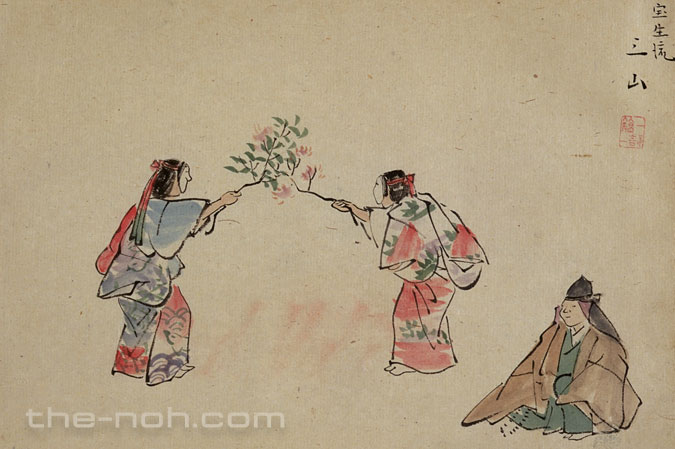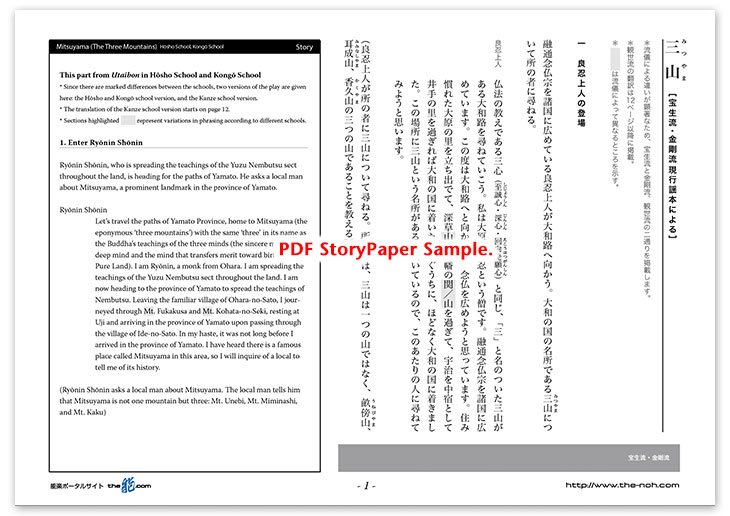
 Mitsuyama (The Three Mountains)
Mitsuyama (The Three Mountains)

![]()
The great Buddhist priest Ryōnin Shōnin, who has left Ohara to spread the teachings of the Yuzu Nembutsu*1 sect throughout Japan, visits Mitsuyama (the eponymous three mountains) in the province of Yamato (present-day Nara Prefecture). A woman appears before Shōnin, who has asked a local man about the history of the three famous mountains in the area. The woman begins to recount the legend of the love affair between one man and two women that is associated with the three mountains. In the story, a man called “Kinnari of Kashiwade” who lives on Mount Kaku, lavished affection on two women, Katsurago*2 of Mount Miminashi and Sakurago of Mount Unebi, but before long the man’s affections shift to Sakurago and the abandoned Katsurago throws herself into a pond on Mount Miminashi, where she drowns. The woman who recounts this love story reveals that she is in fact Katsurago and asks the priest to write her name in his book of believers (the Yuzu Nembutsu) before disappearing into the bottom of the pond on Mount Miminashi.
Shōnin asks the local man to retell story of the three mountains and of Kinnari, Katsurago and Sakurago, and conducts a memorial service. Thereupon, (the ghost of) Sakurago appears, lured by the winds of Mount Miminashi, and asks the priest to release Katsurago from the grudge that haunts her. (The ghost of) Katsurago then appears and, as she speaks of her resentment toward Sakurago, begins attacking the second bride*3, causing Sakurago to suffer. After Katsurago works off her grudge against Sakurago, the two spirits express the wish to find their way to Paradise by receiving a Buddhist blessing from the priest before disappearing into thin air.
*1 Yuzu Nembutsu is a Japanese Buddhist sect that stresses the permeating effect (yuzu) of nembutsu (nem meaning ‘mindfulness’ and butsu being ‘buddha’, thus nembutsu is ‘mindfulness of Buddha’), the invocation of the name of the Buddha Amida (Amitabha Buddha, whose name means ‘immeasurable light’)Thus, the belief was that not only the person who chants the name but all humanity benefits from the practice of nembutsu.
*2 Literally, ‘Child of the Katsura tree’. Cercidiphyllum japonicum, the Katsura tree is native to China and Japan. It is prized for its beautiful shape and attractive deciduous foliage. It is instrumental in Asian folklore and is incorporated into many ancient Chinese and Japanese legends, including an explanation for the shadow on the moon.
*3 This act of a first wife venting her jealousy on a second bride is known as ‘uwanari-uchi’ (literally, ‘slapping a second wife’). This ancient custom of attacking the concubine existed from the end of the Heian period to the early Edo era.
![]()
The play “Mitsuyama” is based on a love story between a man and two women, set on the three famous mountains in the village of Askua (in Nara Prefecture). Although based on the poetic anthology “Manyoshu” (literally, ‘Collection of Ten Thousand Leaves’), the distinctly Noh take on this legend, where Mount Kagu is presented as the husband and the other two mountains as his wives, lends the tale a unique theatricality.
The ‘uwanari-uchi’ performed by Katsurago is a medieval custom in which “after making a declaration, ex-wives would gather their relatives and friends and attack the husband’s new wife,” and is a wild, tempestuous scene. Her bloom long faded, Katsurago’s jealousy and desolation toward the dazzling Sakurago is sublimated through her beating of this second bride.
This play has been performed continuously by the Hōsho school since the mid-Edo period and was incorporated into the Kongō school repertoire at beginning of the Showa era. The modern version of the play as performed by the Kanze school was revived in 1985.
STORY PAPER : Mitsuyama (The Three Mountains)
Story Paper presents noh chant stories in modern speech, with story outlines, highlights and more using Adobe PDF format, which can print out and zoom in. Print out the pages and take them with you when you see the actual noh performance.

The copyright of Story Paper is held by the Noh.com. Story Paper is for individual use only. It is prohibited by the copyright law to distribute or publish printed-out Story Paper pages without prior consent. For more information, check the credit and disclaimer pages.



 [Mitsuyama (The Three Mountains) : Story Paper PDF : 545KB
[Mitsuyama (The Three Mountains) : Story Paper PDF : 545KB